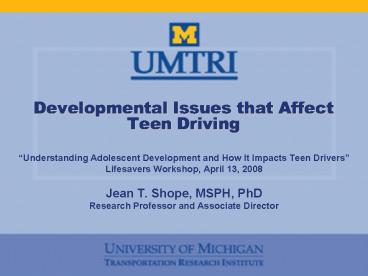Developmental Issues that Affect Teen Driving - PowerPoint PPT Presentation
1 / 26
Title:
Developmental Issues that Affect Teen Driving
Description:
... Affect Teen Driving 'Understanding Adolescent Development and How It Impacts Teen Drivers' ... What driving environment factors affect teens' driving behavior? ... – PowerPoint PPT presentation
Number of Views:220
Avg rating:3.0/5.0
Title: Developmental Issues that Affect Teen Driving
1
Developmental Issues that Affect Teen Driving
- Understanding Adolescent Development and How It
Impacts Teen Drivers - Lifesavers Workshop, April 13, 2008
- Jean T. Shope, MSPH, PhD
- Research Professor and Associate Director
2
- Project Sponsors NIAAA, NHTSA, CDC
- Collaborators Waller, Bingham, Zakrajsek,
Simons-Morton - Colleagues Foss, Williams, and others
3
Overview
- Background
- Longitudinal study
- Influences on teen driving
- Developmental influences on teen driving
- How can knowledge of adolescent development help
safety?
4
BackgroundUS Teen Driving Challenge
Driving Crash Injury Fatality Behavior 4655/day 8
22/day 16/day Prop damage/health care 14B/yr
5
What driving behaviors put teens at risk of crash?
Driving behaviors Speeding Unsafe
passing Tailgating Failure to yield Impaired
driving Lack of safety belt use
6
Longitudinal Study of Young Drivers and
Predictors (NIAAA-funded)
- Followed participants from age 10 - 32
- 13,000 licensed to drive
- Surveys
- Psychosocial measures
- Substance use
- Driving behaviors
- Driver license records and crash records
7
Influences on Teen Driving Behavior
Development
Driving ability
Personality
Demographic factors
Driving behavior
Driving environment
Perceived environment
8
What driving ability factors affect teens
driving behavior?
Driving ability Knowledge Skill Experience
Driving behavior
9
What driving environment factors affect teens
driving behavior?
Driving environment (physical and
social) Night/dark Weather and road
conditions Vehicle access, type, interior
familiar/safe Passengers (age, sex, substance
use) Trip purpose
Driving behavior
10
What demographic factors affect teens driving
behavior?
Demographic factors Age Sex Living
situation Employment Marital/parental status
Driving behavior
11
What personality factors influence teens driving
behavior?
Personality Risk-taking propensity Hostility/aggre
ssiveness Tolerance of deviance Susceptibility to
peer pressure
Driving behavior
12
What perceived environment factors affect teens
driving behavior?
Perceived environment Parents norms, behavior
expectations Parental involvement,
monitoring Peers' norms, behavior
expectations Partners norms, behavior
expectations Risk perception Community
norms Cultural norms Media-advertising,
entertainment
Driving behavior
13
What developmental factors affect teens driving
behavior?
Development Physical Hormones, energy, brain,
sleep Psychosocial Emotional Social
(identity, sexuality) Maturation Parent/peer
relationships Behavioral
Driving behavior
14
Physical Development
- Still growing/not just small adults
- Puberty/hormones raging
- Energy high
- Brain still developing (judgement, impulse
control, decision-making) - Sleep needs and patterns unique
- Need more sleep than get
- Fall asleep and wake up later
15
Psychosocial Development
- Emotional
- Social
- Teens try on identity
- Sexuality
- Maturation, transition to independence
16
Parent/Peer Relationship Development
- Parental nuturance
- Parent/peer orientation
- Parental monitoring
- Parental permissiveness
- Parents attitudes toward behaviors
17
Behavior Change/Development
- Problem behaviors, testing limits
- Friends support for behaviors
- Susceptibility to peer pressure
- Substance use (rapid increase predicts high-risk
driving) - Cigarettes
- Alcohol (availability, early onset, use, misuse,
binge drinking) - Marijuana
- Other drugs
18
How can knowledge of development help teen driver
safety?
- Awareness of multiple influences on teen driving,
including development, prevents adoption of
overly simplistic solutions to complex teen
driving challenge - Better understanding of the teen driver can guide
better policy and programs - Developmental issues can be incorporated into
policy and injury prevention programs
19
How has knowledge of development helped teen
driver safety?
- Evidence-based teen driving safety program
- Graduated Driver Licensing uses a developmental
approach, with teens gaining privileges as
appropriate - Age, stage, experience
- Intermediate level restrictions (night,
passengers, distractions) - Crashes are reduced
20
How has knowledge of development helped teen
driver safety?
- Evidence-based teen driving safety program
- Checkpoints encourages and facilitates
developmentally appropriate parental monitoring
of early teen independent driving - Parent-teen driving agreement structures
communication - Assists with limit-setting
- Risky driving, violations reduced
21
How could knowledge of development help teen
driver safety?
- Extending parental monitoring using electronic
devices not yet evidence-based - Older age of licensure?
- More individual approach?
- Readiness to drive assessment?
- Other?
22
Summary
- Teen driver safety still a challenge
- Many influences on teen driving behavior
- Adolescent development influences important
- Some influences can be changed
- Policies and programs must consider development
and other influences on driving - GDL and Checkpoints a good start
- More creative approaches needed
23
References from Longitudinal Study
- Shope, Waller, Lang. Acc Anal Prev 28 (1996),
755-764 - Copeland, Shope, Waller. J School Health 66
(1996), 254-260 - Elliott, Waller, Raghunathan, Shope, Little. J
Safety Res 31 (2000), 229-242 - Shope, Waller, Raghunathan, Patil. Acc Anal Prev
33 (2001), 649-658 - Waller, Elliott, Shope, Raghunathan, Little. Acc
Anal Prev 33 (2001), 117-128 - Elliott, Waller, Raghunathan, Shope. J Crash Prev
Inj Control 2 (2001), 167-178 - Shope, Bingham. J Stud Alc 63 (2002), 24-33
24
References from Longitudinal Study(continued)
- Elliott, Raghunathan, Shope. J Am Stat Assoc 97
(2002), 420-431 - Shope, Raghunathan, Patil. J Adol Health 32
(2003), 214-224 - Bingham, Shope. J Stud Alc 65 (2004), 84-94
- Bingham, Shope. J Adolescent Research 19 (2004),
205-223 - Bingham, Shope, Tang. Alc Clin Exp Res 29
(2005), 2170-2180 - Bingham, Shope, Raghunathan. J Adolescent Health
39 (2006), 35-42 - Elliott, Shope Raghunathan, Waller. J Stud Alc
67 (2006), 252-260 - Patil, Shope, Raghunathan, Bingham. Traffic Inj
Prev 7 (2006), 328-334
25
References from Longitudinal Study (continued)
- Zakrajsek, Shope. J Safety Res 37 (2006),
443-451 - Bingham, Elliott, Shope. Alc Clin Exp Res 31
(2007), 655-664 - Reference for GDL review
- Shope. J Safety Res 38 (2007), 165-175
- Reference for Checkpoints
- Simons-Morton, Hartos, Leaf, Preusser. Acc
Anal Prev 38 (2006), 907-912
26
Thank you! JShope_at_umich.edu































